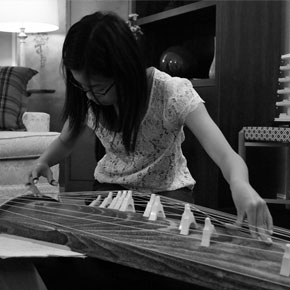

While it may be easier to stick with the mainstream culture, it is often times more rewarding to be part of a more unique crowd. This can be applied to many different aspects of student life at Aragon, but is most easily seen in the school’s musical community.
At Aragon, most music students choose to play a common classical instrument. However, a select-few students’ passion for music has led them to play exotic alternative instruments. These instruments provide a unique outlet for self-expression within the Aragon community.
For some students, playing a unique instrument is a way to embrace their culture. For instance, senior Yue Pang plays the guzheng, a traditional Chinese instrument. The guzheng was developed over 2500 years ago in China. It resembles a long wooden board with 20 strings tied from end to end and is played through plucking the strings.
While it may seem complicated, Pang says, “It’s just like a table guitar.”
Another senior, Sally Hosokawa, plays the koto, a traditional Japanese instrument. “I like that the koto is an instrument from my own culture. I can really be a part of it,” says Hosokawa.
A cousin of the guzheng, the koto has 13 strings and is a common instrument in Japanese chamber music. In Japanese history, the koto music represented a form of entertainment for the royalty and higher class.
A connection with the past can drive students to pick up instruments that would seem out of place in the average modern orchestra or band. Musicians such as Pang and Hosokawa not only experience the cultures their respective instruments embody, but also play a role in their revival and evolution.
Musical instruments are an undeniable way for students to develop strong ties with their cultures. Many of these ties stem from childhood.
Junior Andrew Louden plays the mandolin, a traditional European instrument. His interest in stringed-instruments was born in his childhood.
“When I was little, whenever my mom would take me to the Farmer’s Market, I would stand in front of the guitar player and watch him” he says.
In light of alternative musicians’ obvious dedication to their instruments, one comes to wonder why instruments like the guzheng, koto or mandolin are not as well known as instruments like the guitar or piano.
One important reason is the instruments’ specific styles. With an instrument such as the guitar, one has the ability to play a large range of music across various genres, while playing an instrument such as the koto locks one into a narrower genre. “The koto is solely a Japanese instrument, so not as many people know it as well,” explains Hosokawa.
Despite their instruments apparent lack of popularity and recognition, the musicians that play these alternative instruments all share a similar passion for music. No matter what culture they come from or choose to represent, they are all extremely passionate for the music they play.
“It’s just another vessel for my playing. Another antenna for my creativity,” says Louden.




